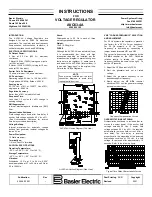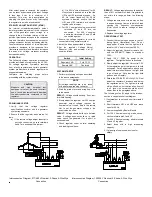
After output power is removed, the regulator
can be reset by decreasing the input voltage
to less than 6 Vac for a minimum of 2
seconds. This may be accomplished by
stopping the prime mover or by interrupting
the regulator input with a reset switch.
STABILITY ADJUST RHEOSTAT (STAB)
An internal screwdriver-adjustable potent-
iometer provides adjustment to the response
rate of the generator output voltage to a
change in load. Clockwise rotation of this ad-
justment provides an increase in the response
time and therefore decreases the amount of
voltage overshoot thereby increasing stability.
Counterclockwise rotation of this adjustment
provides a decrease in the response time
(faster response time) and therefore increases
the amount of voltage overshoot providing
decreased stability.
OPERATION
The following system operation procedures
provide instructions for adjusting the AVC63-
4A voltage regulator. Symptoms resulting
from a faulty regulator and certain generator
system problems are included, together with
suggested remedies.
Complete the following steps before
proceeding with the system startup.
CAUTION
Meggers and high potential test
equipment must not be used. Incorrect
use of such equipment could damage
the semi-conductors contained in the
regulator.
PRELIMINARY SETUP
1. Verify that the voltage regulator
specifications conform with the generator
system requirements.
2. Ensure that the regulator wires are as fol-
lows:
a) If the remote voltage adjust rheostat is
not to be connected, ensure terminals
6 and 7 are shorted with a jumper.
b) If a 55 Hz "corner frequency" for 60
Hz systems is desired, ensure that the
HZ1 and HZ2 terminals are open. If a
45 Hz "corner frequency" for 50 Hz
systems is desired, ensure that the
HZ1 and HZ2 terminals are shorted
together with a jumper.
c) For 120 V nominal sensing, ensure that
terminals V1 and V2 are not
connected. For 240 V sensing,
ensure that terminals V1 and V2 are
connected together.
3. Ensure the voltage regulator is correctly
connected to the generator system.
4. Install the fuses as described in
Fuses.
5. Set the regulator Voltage Adjust
Rheostat (Var) and external Var (if
used) as follows:
Switch
Initial Setting
Regulator VAR
Fully CCW
Remote VAR
Centered
SYSTEM STARTUP
1. Perform preliminary setup as described
in the above paragraphs.
NOTE
All voltage readings are to be taken
with an average-reading voltmeter.
2. Start the prime mover and bring it up to its
rated speed.
RESULT: Voltage should build up. If not, per-
form field flashing.
3. Slowly adjust the regulator Var CW until the
generator output voltage reaches the
nominal value. If used, adjust the remote
Var to set the generator voltage to the
exact value de-sired.
RESULT: Voltage should build up to its rated
value. If voltage does not build up to rated
value, check the generator for a short or
excessive load.
4. Check regulator under normal operating
and loading conditions.
RESULT: Voltage regulation should be better
than ±1.0% no-load to full-load. If regulation is
not within this range, perform the following
steps:
1. Voltage reduction under load may be due
to a speed change from no load to full load
causing the frequency compensation
(V/Hz) circuit to reduce voltage at lower
frequencies.
2.Replace the voltage regulator.
OPERATIONAL TEST
1. Connect the test setup as shown in the fol-
lowing figure,
Operational Test. Do not
apply power. Ensure that the light bulb is
rated for 120 V and is less than 100 W.
2. Adjust the regulator Var and/or remote Var,
and the STABILITY Adjust to maximum
CCW.
3. Apply 120 V, 50/60 Hz power to the
regulator. The light bulb should illuminate.
4. Slowly adjust the regulator Var control CW.
At the regulation point, the light bulb should
extinguish. Small adjustments above and
below this level should cause the light bulb
to go off and on. Note that the light bulb
goes on and off rapidly.
5. Rotate the STABILITY ADJ fully CW. Now
adjust the regulator Var above and below
the regulation point. The light bulb should
still go off and on but the transition from off
to on (and vice versa) should be much
slower than in the paragraph above.
The following notes (
∆
) apply to the intercon-
nection and operational test diagram:
1. If external pot is not used, short terminals 6
and 7.
2. Short terminals HZ1 and HZ2 and leave
open for 60 Hz.
3. Item not supplied by Basler Electric.
4. For 120 V Nominal sensing, make no con-
nection to terminals V1 and V2.
For 240 V Nominal sensing, short terminals
V1 and V2 together.
5. Select fuses with a high interrupting
capacity.
6. If glass type fuse is used, enclose for
safety.
Interconnection Diagram, 277/480 V Nominal, 3-Phase 4-Wire Wye
Interconnection Diagram, 120/208 V Nominal, 3-Phase, 4-Wire, Wye
Connection
Connection





















